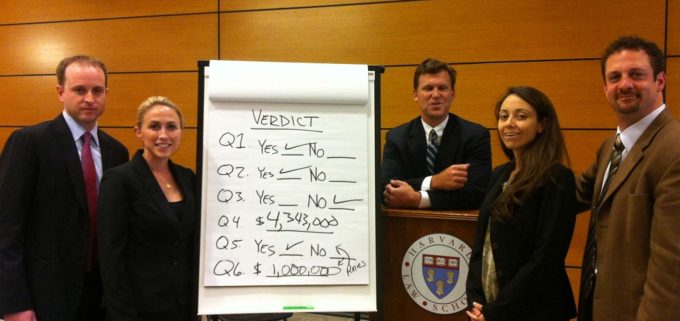There are few, if any, lawyers who are unfamiliar with Scott Turow’s classic autobiographical account of his first year at Harvard Law:
“It is Monday morning, and when I walk into the central building, I can feel my stomach clench. For the next five days I will assume that I am somewhat less intelligent than anyone around me. At most moments I’ll suspect that the privilege I enjoy was conferred as some kind of peculiar hoax. I will be certain that no matter what I do, I will not do it well enough; and when I fail, I know that I will burn with shame.
I am a law student in my first year at the law, and there are many moments when I am simply a mess.”
Most of us read it while preparing to start law school – at a time when the law is primarily an academic experience. I guess it takes a certain kind of person to read this and still be drawn to the law…and it’s with that idea that our story begins.
Imagine my intrigue upon learning I would get to spend a week at Harvard Law School for the American Board Of Trial Advocates (ABOTA) Trial College this past summer. In 2005, I attended a similar program at my own law school – the Maurer School of Law in Bloomington – conducted by the National Institute for Trial Advocacy. Thus, when a very respected, more experienced colleague recommended I apply for the Trial College at Harvard, I knew it would be an intense and rewarding week to say the least. And it was.
Thirty-six trial lawyer “students” from across the United States spent a week with about 25 of the most experienced, talented, respected trial lawyer “faculty” in the United States…learning, teaching, laughing, stressing, breathing, and sleeping (although only a few hours of sleep per night) trial practice. This was done by fully preparing a “mock” (not real – though based on actual events) case for trial, and then actually trying the case – in front of a real sitting judge, and a real jury – at the end of the week. Throughout the process, each student lawyer prepared each part of a trial presentation – from case theories, to opening statements, to direct exams, to cross exams, to expert witness preparation, presentation and cross, to closing arguments – and was individually critiqued on their performance. On the final day, the students were divided into “teams” for a trial.
Who did I meet there? An amazing group of faculty and students – an equal number of plaintiff and defense lawyers – who reinvigorated my faith in, and respect for, the legal profession. Allow me a brief digression.
One of the unfortunate occupational hazards of being a trial lawyer is the temptation to develop a prejudice toward your adversary and, thus, succumb to what is described in the Social Sciences as the Social Identity Theory or the In Group/Out Group Theory. To oversimplify, this theory states that the groups we belong to (religious, political, school we attended, team we root for, etc.) are an important source of our self-image and self-esteem. Therefore, without realizing it, we often inflate (in our own minds) the status of the group to which we belong, and discriminate against the group or groups to which we do not belong. We all do it. This phenomenon has always intrigued me since I was first exposed to the theory as a political science student at Purdue. I then made a practice of looking for it in myself and others, as I attended both Purdue and then Indiana, worked as a civil (not criminal) defense lawyer and then as a plaintiffs’ lawyer, and in other situations too numerous to list. A recent experience for many has involved Peyton Manning wearing a different jersey.
In any event, for one week at Harvard, every lawyer in attendance – regardless of on which side of the “V.” they usually find themselves – focused only on the art of trial advocacy: presenting your case to a jury. The skills are the same. I mention it only because there are far too few opportunities in a trial lawyer’s professional life to set aside the understandable adversarial tension, and celebrate a mutual admiration for the art of a jury trial.
What did I learn and bring back with me? Far too many things to cover them all, so I will simply pick a good example:
The case that we worked on and ultimately tried to a jury of Boston residents involved a man (the Plaintiff) who developed lung disease from exposure to a product. As we worked that week through all of the details, witnesses and evidence in the case, there was an absolute agreement among all faculty and students that the man would most likely lose his case. There were too many risky facts that favored the defense, and I can tell you that – had this case been real – it would have been VERY difficult to turn down even a modest offer of settlement as the plaintiff’s lawyer. But the case was not real, and this was a TRIAL College, not a SETTLEMENT College…so we tried the case.
There were three separate trials. I was on one of the three Plaintiff’s trial teams. All three verdicts were for the Plaintiff, and I was particularly pleased to be on the team awarded the largest verdict.
Lesson re-learned: Juries do not always focus on the facts and evidence that we lawyers think are most important. That is why we very much need them.
